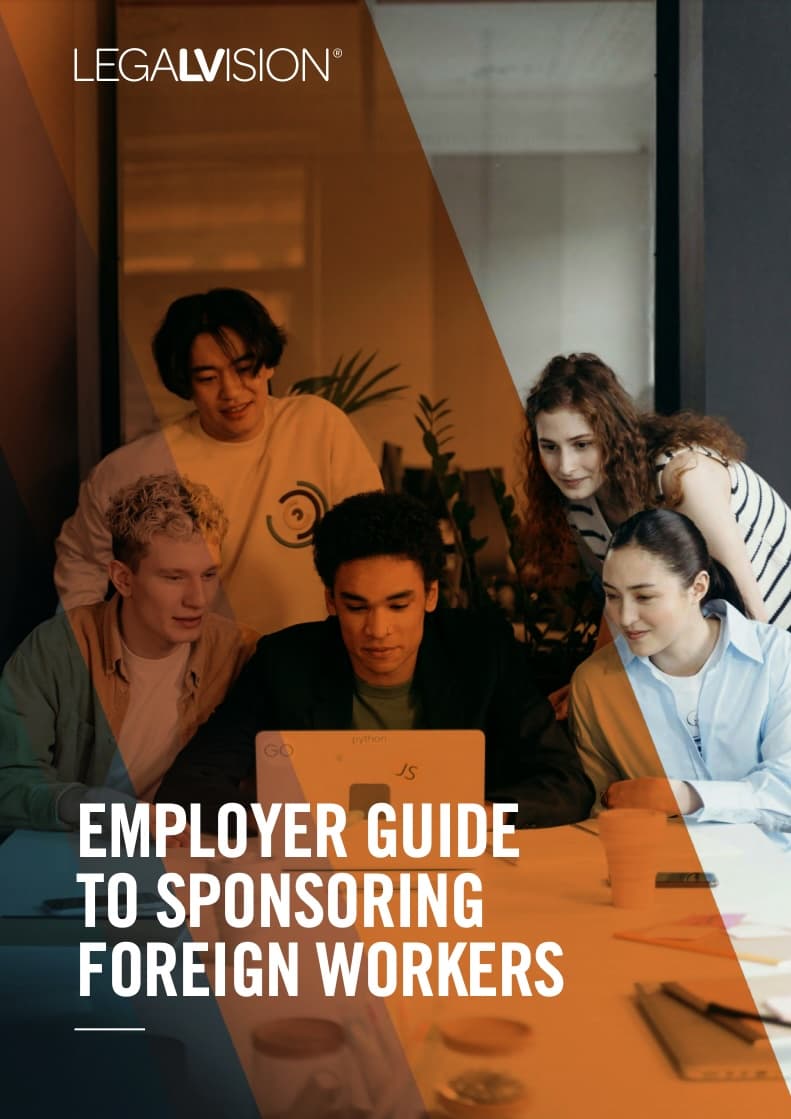The purpose of the training visa (subclass 407) is to allow Australian organisations and government agencies to support individuals from overseas to engage in certain occupational training activities, such as professional development sessions in a classroom setting or on-the-job training. This article will explore how your business can sponsor a candidate under a training visa.
Training Visa (Subclass 407)
As a business, the subclass 407 training visa allows you to sponsor a foreign national to work for you temporarily in a structured training program so they can either:
- meet registration or licensing requirements for their occupation (stream 1);
- enhance their skills for their occupation (stream 2); or
- promote capacity building overseas (stream 3).
You can obtain a training visa can for up to two years. Therefore, it may be suitable for individuals unable to qualify for other employer-sponsored visas, such as the temporary skills shortage visa (TSS). For example, an overseas student without relevant work experience may be suitable for the training visa. Note, however, that the 407 visa is not intended to address shortages. Unlike the TSS visa, providing work opportunities is not its primary objective. As contemplated in its title, the purpose of the 407 training visa is to provide training. Hence, it is unsuitable for those who primarily aim to work.
You can lodge all three applications at the same time. However, the applications will be assessed in the order detailed above. For instance, the Department of Home Affairs (DOHA) must first approve the sponsorship application before processing the visa application.
This article will discuss the key stages when sponsoring a candidate under the training visa and the requirements you must meet at each stage.
Stage 1: Sponsorship Application
When sponsoring an individual under the training visa, you must first apply to become a temporary activities sponsor. An approved sponsorship is valid for up to five years. During this time, you can nominate and sponsor applicants for the training visa.
Am I Eligible to be a Temporary Activities Sponsor?
To be an approved temporary activities sponsor, you must be:
- an Australian organisation lawfully established and operating in Australia (e.g. a company, partnership or non-profit organisation). This does not include an individual or sole trader;
- an Australian Commonwealth, State or Territory government agency;
- a foreign government agency lawfully operating in Australia (e.g. a consulate, trade office or other foreign national government entity);
- an international organisation recognised by Australia and lawfully operating in Australia (e.g. the United Nations);
- an organisation that operates a superyacht or the owner or captain of a superyacht;
- a sporting organisation lawfully operating in Australia; or
- a religious institution operating lawfully in Australia.
To demonstrate that you fall within one of the above categories, you must provide supporting evidence. For example, you may provide your Australian Securities and Investments Commission (ASIC) company extract. You must also show that you are lawfully operating a business in Australia. You may demonstrate this via:
- ABN Extract;
- copy of the lease; or
- contracts carried out by the business.
Furthermore, you must demonstrate that you can directly provide the occupational training unless you are exempt (e.g. you are an Australian Commonwealth Government agency). This involves providing a training plan that outlines the structured training program the candidate will undertake to attain the required skills and experience.
Lastly, you must demonstrate that you can meet your obligations as a sponsor in a formal statement. For example, as a Temporary Activities Sponsor, you must keep certain records that show you comply with your obligations and ensure that the candidate only works in their nominated occupation or program.
Continue reading this article below the formStage 2: Nomination Application
The second stage of the application process requires you to nominate the occupation and candidate. There are three streams under which you can nominate an individual. Namely, these are occupational training:
- required to meet certain registration or licensing requirements;
- to improve skills in an eligible occupation; and
- for capacity building overseas.
The nomination requirements are different for each stream. Let us explore the requirements further below.
Stream 1: Required for Registration
This stream may apply when the training is necessary for the candidate to obtain a specific registration, membership, or license to work in Australia or their home country. For example, in Australia, many jobs require registration or licensing before you can start working.
Practical examples include the requirement to:
- be registered with the teacher registration board in your State to work as a teacher in Australia; and
- hold an electrical work licence to work as an electrician in Australia.
Note that this stream is unsuitable for applicants already working in an occupation and only seeking to qualify. An accountant seeking qualification as a chartered accountant is an example.
The Australian and New Zealand Standard Dictionary of Occupations (ANZSCO) is a good starting point to determine if a particular occupation requires registration or license.

Sponsoring overseas workers as an Australian business is complicated. Let us simplify it for you with this free employer guide.
Stream 2: To Improve Skills
Applicants who wish to improve their skills in their occupation may be eligible under this stream. To nominate someone under this stream, you must show the following:
- the workplace-based structured training program is tailored to the training needs of the nominee;
- the training program is related to an occupation specified by the Minister (LIN 19/050) on the list of eligible skilled occupations; and
- the nominee has at least 12 months of full-time relevant experience in the occupation in the 24 months before lodgement of the nomination.
The critical factor in determining whether a work experience is relevant is whether the skill sets underpinning the work experience are complementary and enhanced in the nominated training.
You must provide supporting evidence, including your training plan and the nominee’s resume.
The training plan cannot be generic, and you must tailor it to the training needs of the individual. Additionally, you must set out clear learning outcomes in the training plan and specify how you expect the individual to meet these learning outcomes.
Stream 3: For Capacity Building Overseas
This stream allows you to train someone to promote capacity building overseas. This means that the training you provide must be:
- specifically tailored to the nominee’s training needs, and the nominee must complete a maximum of six months of practical experience to obtain a foreign qualification;
- specifically tailored to the nominee’s training needs and supported by their home government (or an Australian government agency; or
- a professional development training program run primarily through face-to-face teaching in a classroom or similar environment.
You should ensure that the training you provide is ‘workplace-based’, meaning at least 30 hours of training per week, of which at least 70% is conducted in the workplace (as opposed to in a classroom).
Take note that if an applicant is undertaking a research project towards a postgraduate degree award with a foreign institution, the Subclass 408 (Temporary Activity) visa – Research Activity could be a more suitable option.
Stage 3: Training Visa Application
The final stage involves lodging the visa application. Again, the candidate may apply, or you may do so on their behalf.
All applicants for the training visa must:
- be at least 18 years old;
- have the skills, experience and qualifications necessary to undertake the occupational training;
- have at least functional English;
- genuinely intend to stay temporarily in Australia to undertake the specified occupational training;
- be able to support themselves financially during their stay in Australia;
- have made adequate arrangements for health insurance during their stay in Australia; and
- meet the relevant health and character criteria.
The visa application should outline how the applicant meets the above criteria and provide supporting evidence where appropriate.
Apportionment of Costs
Please be mindful that the paying for visa sponsorship legislative framework, including penalties, applies to the subclass 407 visa. The sponsor must pay all the costs of applying to become a temporary activities sponsor and the nomination application.
Key Takeaways
The subclass 407 training visa in Australia is a great tool to allow someone to work for you whilst undertaking on-the-job training. Sponsoring someone under the training visa is a three-step process:
- sponsorship application;
- nomination application; and
- visa application.
Once the DOHA has approved all three applications, your candidate will receive a training visa for up to two years. If you have any questions about the training visa, our experienced immigration lawyers can assist as part of our LegalVision membership. For a low monthly fee, you will have unlimited access to lawyers to answer your questions and draft and review your documents. Call us today on 1300 544 755 or visit our membership page.
Frequently Asked Questions
Yes. The primary applicant can include their spouse and dependants as secondary applicants.
No. The sponsor must pay for all the costs associated with applying to become a temporary activities sponsor and the nomination application. The applicant, however, is allowed to shoulder the costs associated with the actual visa application.
We appreciate your feedback – your submission has been successfully received.











